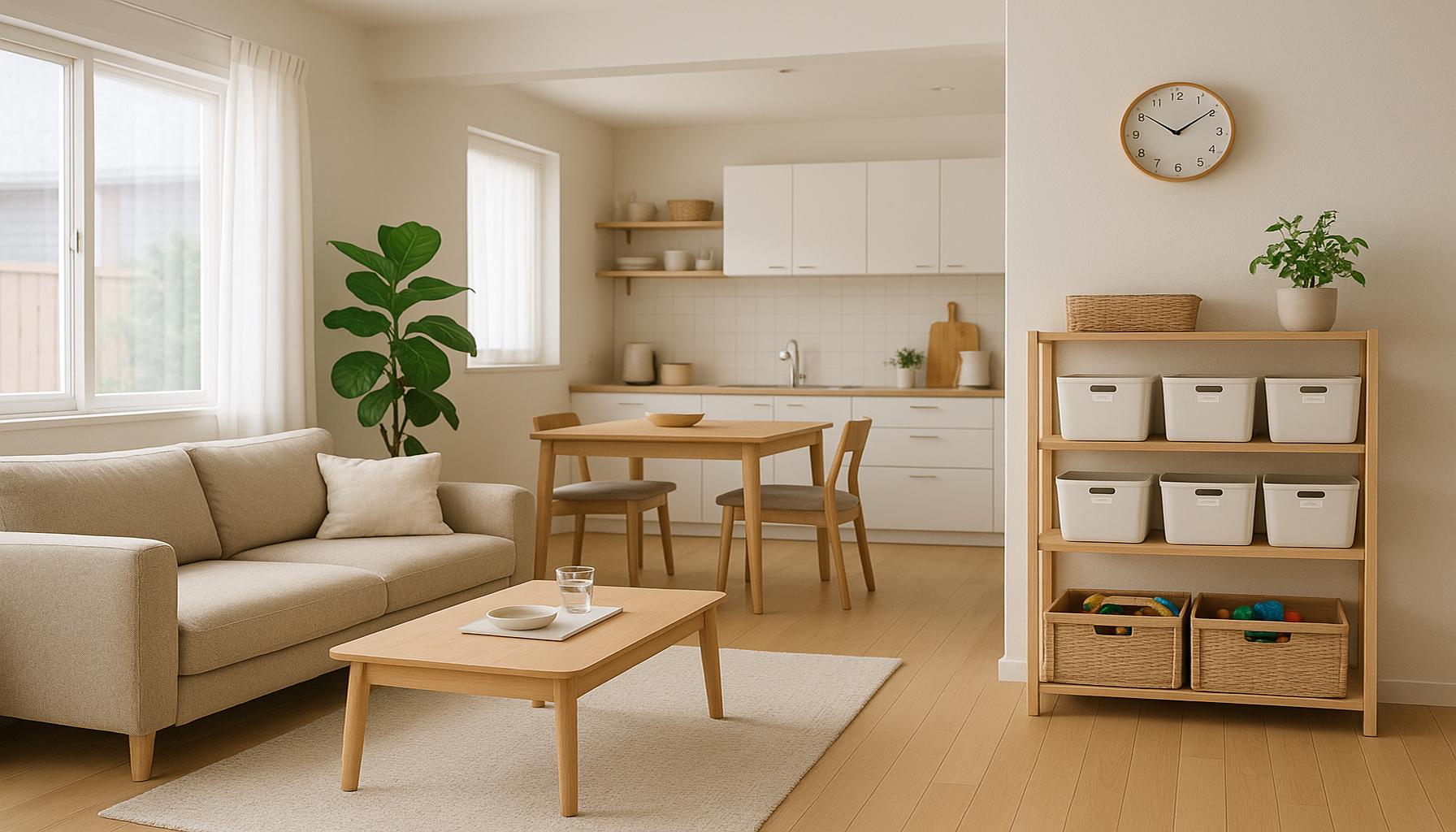Minimalist organization strategies to maximize efficiency in family environments

Transforming Family Dynamics with Minimalist Organization
In a society that thrives on busyness and multitasking, many families find themselves overwhelmed with clutter and chaos in their daily lives. Juggling work commitments, children’s activities, and household responsibilities can be a daunting task. Focusing on minimalist organization strategies offers a refreshing solution to not only streamline routines but also create a peaceful home environment.
Embracing minimalism isn’t just about throwing out unwanted items; it’s a holistic approach that reshapes how families interact with their belongings and each other. By simplifying spaces and prioritizing essentials, families can enhance their quality of life. Here are some pivotal elements to consider:
- Decluttering: This involves more than just a one-time cleanup. Regularly assessing belongings is crucial. For instance, using the “one-in, one-out” rule ensures that every new item brought into the home is balanced by the removal of another. This practice prevents accumulation and fosters mindful consumption.
- Organized Zones: Establishing defined spaces for specific activities can drastically improve efficiency. For example, designating an area in the kitchen for homework can help keep distractions at bay during study time. Similarly, creating a cozy corner for family meals encourages connections and reduces chaotic dining experiences.
- Shared Responsibilities: Teamwork is vital in any household. By dividing up tasks, such as assigning weekly cleaning duties or meal planning among family members, you create a sense of ownership and cooperation. This participation not only alleviates stress but also teaches children valuable skills.
Implementing these strategies can lead to more than just a neat home; it can improve mental clarity and efficiency in daily tasks. For example, a family that adopts a minimalist mindset often finds a surprise benefit: less time spent searching for lost items translates to more quality time together. Parents report feeling less stressed and more present with their children when the environment isn’t chaotic.
As families explore the transformative effects of minimalist organization, they may unlock the potential for meaningful connections and memorable experiences. Practical tips, such as using storage bins for common toys or color-coding family calendars, can be easily integrated into everyday life. Each small change contributes to a larger goal: a harmonious home where focus shifts to what truly matters, fostering growth and joy.
Overall, by delving into minimalist organization methods tailored for family environments, you’ll discover that simplicity doesn’t equate to deprivation but instead invites abundance in relationships and experiences. The path to a more organized and tranquil home is not as daunting as it seems, and the rewards are truly transformative.
DIVE DEEPER: Click here to discover how minimalism can enhance your productivity
Essential Minimalist Strategies for Family Efficiency
Adopting minimalist organization strategies in family environments is about more than aesthetics; it’s a practical approach that can lead to significant improvements in efficiency and family cohesion. To maximize the benefits, families should consider implementing the following techniques:
- Establish a Family Command Center: A central hub for all family activities is critical. By creating a dedicated space—whether it be a bulletin board, a calendar system, or a digital planner—family members can easily access schedules, assignments, and keys to the house. This minimizes miscommunication and chaotic mornings, ensuring that everyone stays on the same page.
- Reduce Decision Fatigue: Simplifying daily choices can significantly enhance productivity. For example, creating a weekly meal plan and grocery list allows families to shop less frequently and prepare meals more efficiently. Moreover, having a standardized outfit or uniform for kids can streamline morning routines, reducing stress for both parents and children.
- Implement Smart Storage Solutions: Utilizing vertical space and multifunctional furniture can free up valuable square footage while keeping essential items accessible. Clear bins, labeled drawers, or creative solutions like under-bed storage can help maintain order without overwhelming spaces. This way, families can easily locate and manage their belongings.
- Prioritize Quality Over Quantity: Engaging in mindful consumption is crucial for achieving a minimalist lifestyle. Families can benefit from making intentional purchases that add genuine value to their lives rather than just filling spaces. This shift encourages investing in durable and versatile items that promote long-term satisfaction.
- Family Meetings: Regularly scheduled family meetings create a platform for discussing schedules, upcoming events, and household priorities. These gatherings help acknowledge each member’s contribution, address conflicts, and solidify a collective approach to organization. By fostering open communication, families can adapt their strategies to better suit changing needs.
Each of these strategies contributes to a more organized household that maximizes time and energy, reducing the ubiquitous feeling of overwhelm many families face today. The implementation of these minimalist practices can lead to a notable increase in overall efficiency, allowing families to focus their attention on what truly matters—supporting one another through the ups and downs of everyday life.
The shift to a minimalist organizational system can feel daunting initially, but the transition paves the way for not only tangible results but also emotional benefits. Families often find that a clear space reflects a clear mind, allowing them to foster deeper relationships and create lasting memories.
In family environments, organization can often feel like a daunting task, but implementing minimalist strategies can create a sense of clarity and efficiency. By focusing on the essentials and eliminating clutter, families can foster a more harmonious living space, allowing for better routines and interactions. One effective approach is the “one in, one out” rule, where for every new item brought into the home, an existing item is donated or discarded. This method not only reduces unnecessary clutter but also teaches children the value of mindfulness and responsibility regarding their belongings.
Another strategy is to create designated zones for specific activities. For instance, establishing a homework station away from distractions can enhance focus for children, while a family calendar placed in a central location promotes better communication and scheduling of activities. Additionally, integrating storage solutions that align with minimalist principles—such as multifunctional furniture or built-in shelves—can optimize space without overcrowding the home.
Effective organization extends beyond physical items; it involves establishing routines that serve to maximize efficiency. For example, dedicating a specific time each week for decluttering or family planning can prevent chaos and ensure everyone’s tasks and schedules are aligned. These minimalist organization strategies not only simplify daily life but also encourage a supportive family atmosphere that values cooperation and shared responsibility.
| Category | Benefits |
|---|---|
| Clutter Reduction | Enhances mental clarity and reduces stress. |
| Enhanced Routines | Increases productivity and fosters family cooperation. |
By adopting these minimalist organization strategies, families can not only reclaim their living spaces but also inspire greater efficiency in daily tasks, leading to a more balanced and joyful home life. Embracing minimalism may initially require a shift in mindset, but the extraordinary benefits it brings are well worth the effort.
DIVE DEEPER: Click here to enhance your time management skills
Innovative Approaches to Enhance Family Organization
As families explore minimalism to improve their organization, additional strategies can further bolster efficiency while encouraging a harmonious home environment. By focusing on these innovative methods, families can streamline their lives and deepen their connections.
- Embrace the One-In, One-Out Rule: To prevent clutter from accumulating, families can adopt the one-in, one-out philosophy. For every new item brought into the home, an existing item should be removed. This rule not only curtails excess but also encourages thoughtful purchasing decisions. Think about the satisfaction derived from donating unused toys or clothes, which not only clears space but also benefits others in your community.
- Utilize Digital Tools for Streamlined Communication: In this digital age, families can leverage technology to ease communication and organization. Apps like family calendars or task managers allow family members to share schedules, coordinate appointments, and assign chores efficiently. These tools serve to ensure that everyone is aware of each other’s commitments, minimizing scheduling conflicts and enhancing accountability.
- Create Zones for Activities: Designating specific areas within the home for distinct activities can lead to greater organization. For instance, homework zones equipped with necessary supplies and quiet corners for relaxation can promote focus and productivity. Similarly, a dedicated play area for children can keep toys contained, reducing mess and fostering responsible habits as kids learn where things belong.
- Incorporate Time-Batching Techniques: Time batching involves grouping similar tasks together to optimize efficiency. For example, setting specific times for laundry, meal prepping, and family cleaning sessions can minimize interruptions throughout the week. By dedicating focused time blocks for household chores, families can experience a more structured and peaceful home life, ultimately saving time that can be spent enjoying each other’s company.
- Involve Children in Organizational Tasks: Teaching children the value of organization can have long-lasting benefits. Involving them in the decluttering process and explaining the importance of maintaining an orderly space fosters a sense of responsibility and teamwork. It empowers them to take ownership of their belongings while reinforcing family bonds, as working together cultivates shared goals and cooperation.
- Seasonal Purge and Reassess: Regularly scheduled seasonal purges not only help maintain a minimalist environment but also encourage continuous evaluation of what truly adds value to family life. This ritual can foster discussions that assess changing needs, as children’s interests and activities evolve. By engaging in this practice, families can better align their space with their lifestyle and priorities.
The integration of these strategies can fundamentally shift how families operate within their homes. By embracing minimalism holistically, families not only achieve improved organization and efficiency but also strengthen their connections with one another. Each strategy builds upon the next, creating a sustainable approach that fosters an environment of clarity and purpose. The simplicity brought forth by these methods encourages families to thrive in a space that is not just functional, but also nurturing and supportive.
DON’T MISS OUT: Click here to dive deeper
Conclusion: Embracing Minimalism for a Balanced Family Life
In summary, the journey towards a more organized and efficient family environment through minimalist organization strategies can lead to transformative changes, both in how families function and in their overall quality of life. By adopting simple yet effective approaches like the one-in, one-out rule and utilizing digital tools, families can cultivate an orderly space that minimizes clutter and maximizes joy. Establishing activity zones and implementing time-batching techniques allows for a structured domestic routine, creating a sense of balance amid life’s chaos.
Moreover, involving children in organizational tasks not only teaches them valuable life skills but also reinforces the importance of teamwork and shared responsibility. Regular seasonal purges can foster ongoing discussions about family values and priorities, ensuring that each member contributes to the upkeep of a harmonious space. This continuous evaluation creates a responsive environment that adapts to the evolving needs of all family members.
Ultimately, embracing minimalism goes beyond mere organization; it shapes the family dynamic, enhancing connections and enriching experiences. As families prioritize clarity and purpose within their homes, they unlock the potential for deeper relationships and a fulfilling lifestyle. By adopting these strategies, families can embark on a path of intentional living, fostering not just efficiency but also a nurturing atmosphere where everyone thrives.


